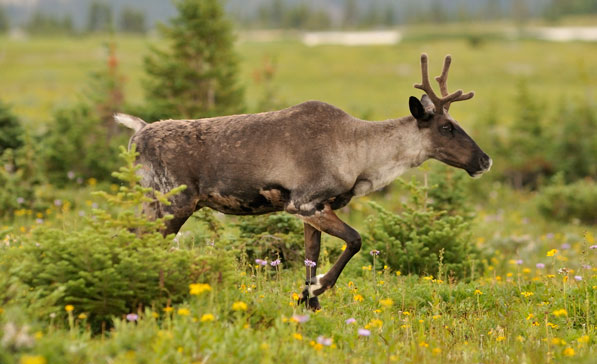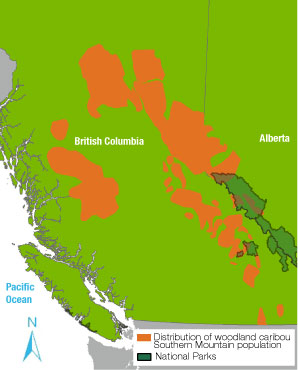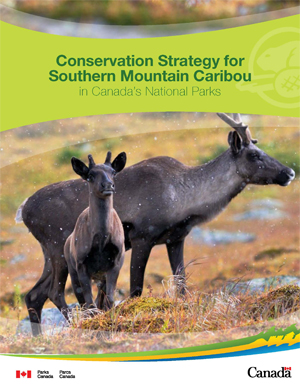Southern Mountain Caribou conservation
Woodland Caribou - Species at Risk

“There’s a caribou!” Word spread quickly in and around the wilderness lodge in the Tonquin Valley of Jasper National Park. Soon the whole group had gathered, cameras in hand, to watch a lone female prancing skittishly through the alpine meadow nearby. Looking goofy as only a caribou can, like a teenager not yet grown in to overlarge feet, she ran back and forth as though trying to out-manoeuvre an unseen predator or a swarm of mosquitoes. In the days leading up to this backcountry excursion, the group of youth from across Canada had learned about woodland caribou. They’d felt the thick fur of a caribou hide; held a foot to see the large toes that act as shovels, paddles and snowshoes; discussed the challenges faced by caribou today; dressed as caribou to showcase their unique features; and listened to stories of first hand experiences with caribou in the mountain national parks. Now, not only were they in one of Jasper’s most awe-inspiring landscapes, they were also lucky enough to see a caribou in the wild. For these youth, mostly from large cities, it was an experience they won’t soon forget.

Unforgettable experiences like this happen every day, as people like you explore and connect with your protected national treasures. As an international leader in protected areas management, Parks Canada protects these specials places for you and for the wildlife that call them home. In the mountain national parks, woodland caribou recovery is a priority. We are taking action to protect the park ecosystems woodland caribou depend on to survive. Through initiatives like this, Parks Canada is contributing to goals under Canada's National Conservation Plan to restore ecosystems and connect Canadians to nature.
Woodland caribou are found in the boreal forests and mountain regions of Canada from Newfoundland to British Columbia and north into the Yukon and the Northwest Territories. They are a medium-sized member of the deer family, rich brown in colour with white necks. Unlike the great herds of barren-ground caribou to the north, woodland caribou are usually found in small groups. They live in old growth forest and high alpine areas. These often hard-to-access areas help them avoid predators. Caribou found in Jasper, Mount Revelstoke and Glacier national parks belong to the Southern Mountain population of woodland caribou. They are distinct from most other woodland caribou in their use of mountain habitat. They do not migrate like many other caribou but rather move elevationally in response to seasonal changes.
Conservation Update
With the release of the Recovery Strategy for the Woodland Caribou, Southern Mountain population in Canada in June 2014, Parks Canada has a legal obligation to prevent the destruction of caribou critical habitat. In the mountain national parks, significant critical habitat protection measures are already in place.
Woodland Caribou
Transcript
Woodland Caribou
A video about woodland caribou found in the mountain national parks of Banff, Jasper, Glacier and Mount Revelstoke. The video outlines the five key threats faced by this species at risk, and highlights current research in Jasper National Park. The video also shows biologists at work in the field.
Text:
(Parks Canada beaver logo) parkscanada.pc.gc.ca
A film by Cam Koerselman
Audio:
Deep in the Tonquin Valley of Jasper National Park, Parks Canada biologists are on a mission. They are out to investigate a potential caribou kill site as part of an ongoing program to monitor wolf kill rates in the park. But it’s not an easy task, not only is it a 50km hike through difficult back-country terrain, searching for the licked-clean cast-offs of last winter’s hungry wolf pack feels like finding a needle in a haystack. But the biologists have come prepared…. using GPS data from collars on the wolf pack, the biologists use their own GPS unit to guide them to within meters of where the wolves might have made their kill.
Narrator introduces work of Jasper National Park biologists with video from the Tonquin Valley in Jasper National Park: clouds moving over Amethyst Lake, alpine flowers, the Ramparts, a marmot on a rock, people with backpacks hiking through forest, meadow and crossing a creek, a wolf, image of a wolf with a kill, mountain scenery, people hiking, woman with backpack using GPS and looking around on the ground.
Audio:
Should be right around here.
Biologist Layla Neufeld speaking in video while holding GPS and looking around.
Audio:
The biologists search the site, but no carcass can be found; meaning that the wolves most likely used the area last winter as a bedding site, and not for a feast.
Narrator continues with video of two biologists looking for a kill site in bushes.
Audio:
It’s good that were liberal with the definition of what a kill site is because we’ve had situations where we’ve been to a site and there have only been 2 or 3 hours that the animal was at the site, and we’ll get there and there will be a kill, and what has happened is that the GPS can’t quite reach the satellite due to either cover or a big cliff or rocks somewhere around so it helps us find where the cut-off is between a bed and a kill.
Text:
Layla Neufeld, Caribou Biologist
Layla Neufel, Caribou Biologist, discusses wolf kill sites. Video images are of her and another biologist looking for a kill site, and a mountain lake scene.
Audio:
But finding no kill is certainly not disappointing… because woodland caribou herds in the Rocky Mountains don’t have many more members to lose.
Narrator continues with close up video of a caribou and a view of the Ramparts in the Tonquin Valley.
Audio:
Our last census was 87 and there could be as many as 96, so just under a hundred here in Jasper, we figure back in ’88 there was about 175 so we’ve had a decline since then. Banff National Park of course, there was only about 5 and all of them were killed in an avalanche, so odds are they have been extirpated in Banff National Park.
Text:
Mark Bradley, Caribou Biologist
Mark Bradley, Caribou Biologist, explains current status of caribou in Jasper and Banff National Parks with video of Tonquin Valley scenery and a herd of about 10 caribou.
Audio:
So within Canada there’s a lot of different types of caribou and the one on the quarter is the one that people probably grow up learning about and seeing but most of the time when people think about caribou they think about barren-ground caribou - large herds, migratory animals, moving to the coast to calve, and then back, but woodland caribou generally live below treeline in Canada, don’t have large migrations, don’t move to the coast and don’t live in large groups. A lot of people are surprised to learn that we have woodland caribou as far south as jasper and into southern B.C and even down into the United States.
Layla Neufeld talks about caribou in Canada with video of caribou in the Tonquin Valley.
Audio:
For the woodland caribou that spend time within the mountain national parks, Parks Canada is actively doing research to learn the best way to maintain stable populations. They have come up with five key threats to caribou.
Narrator continues with video images of Layla using a telemetry antennae and receiver while another Parks Canada employee looks on, close up of the antennae, and Layla looking over a data sheet.
Audio:
The first of the threats, and the one that is being managed most, is altered predator prey dynamics. This threat starts with having a stable, over-inflated population of elk in the park. And having increased numbers of elk sustains more wolves – more wolves that can kill more caribou.
Narrator explains the first threat while screen shows a large number one and five video images on the left hand side: 2 videos of wolves, one of a 70 km/hr caribou crossing speed sign, one of a cut block, and one of caribou. The video images represent the five threat categories. The screen zooms into the first video of a wolf followed by footage of a bull elk feeding in the grass, a wolf, and a caribou.
Audio:
The second threat is increased predator access.
Narrator introduces the second threat. Screen shows a large number two with the five threat video images, zooms into the second wolf video.
Audio:
So caribou live up in these high reaches of the mountains, especially in winter time they use this space to separate themselves from wolves. When we create tracks that go into caribou habitat, we create a perfect trail, a wolf can access caribou habitat easily and this increases risk to caribou.
Layla Neufeld describes the threat of predator access with video images of caribou in the Tonquin Valley, a cross-country skier, and a wolf.
Audio:
The third threat is human disturbance.
Narrator speaking. Screen shows a large number three and the five threat videos; zooms into the third video of the caribou crossing speed zone.
Audio:
In Jasper National Park we’ve lost about 13 caribou since 1988 on the Icefields parkway; this is a fairly preventable loss and ends up being a fairly large factor to the population decline, so we’ve worked on speed zones in those areas. When we're hiking and accessing areas that are caribou habitat, sometimes caribou react and run great distance from us.
Layla Neufeld describes the threat with video of Angel Glacier, a caribou scene where one caribou fades out of the picture, a 70 km/hr caribou crossing speed zone with a car driving the Icefields Parkway in winter, two women hiking, and caribou running.
Audio:
The fourth threat is habitat loss.
Narrator introduces fourth threat while screen shows a large number four and the five small videos. It zooms into the fourth video of a cut block.
Audio:
We don’t see a lot of that within the national parks, but one example of that is potentially fire - which changes habitat for caribou. Outside of the national park were talking about things like cut blocks, pipelines, and seismic lines.
Layla Neufeld speaking with images of forest fires and a cut block.
Audio:
The fifth threat is small population size, and as proven by the loss of the entire Banff herd in just one avalanche, normal impacts on small populations are magnified making each animal precious.
Narrator describes fifth threat. Screen shows large number five with the five small videos. It zooms into the last video with scenes of caribou in the Tonquin Valley.
Audio:
Caribou are a really cool species that are highly adapted to a unique environment. They have really unique features and they live in places where really only they can survive. They are connected to us in so many ways, culturally connected, economically connected, they’re one on the first deer species that we grow up learning about just because of the fact that they are on our money. They are good indicators for an ecosystem and for when an ecosystem is in trouble. And for all these reasons I think we should all be involved in learning about caribou, and participating in caribou recovery, giving our opinions about caribou when we are asked, and just staying informed about caribou, caribou ecology.
Layla Neufeld describes the importance of woodland caribou with video of the Ramparts in the Tonquin Valley, a yellow alpine flower with a bee on it, and of caribou.
Text:
To learn more, visit pc.gc.ca
Music by Aiden Knight and Kevin MacLeod
Special thanks to: Marcia deWandel, Shelley Bird, The Nature Conservancy of Canada for photos of cutblocks, Mark Bradley for wolf photo, Steve Malcom for fire photos, Colin Koerselman, Lindsay Gergel
What actions are being taken to protect critical habitat?
- Monitoring and management activities to reduce predation risk;
- Maintenance and protection of old-growth habitat;
- Consideration of critical habitat protection in fire and vegetation management plans and integrated land-use planning;
- Adjustments to the timing of winter access in areas of caribou habitat; and
- Reduced speed zones and/or caribou crossing signs on roads through critical habitat.
Here is the latest news on caribou research and conservation in the mountain national parks.
Mountain National Parks Caribou Conservation Program - Winter 2016 (PDF 1.14 MB)
Conservation update on woodland caribou - Winter 2015 (PDF 1600 KB)
Jasper National Park
Caribou conservation: delayed winter access
Parks Canada is a leader in caribou conservation and Jasper’s vast mountain landscape – more than 11,000 square kilometres – supports both diverse winter recreational opportunities and significant protection of caribou habitat.
To protect winter caribou habitat in Jasper National Park:
- Winter access is delayed annually from November 1st until February 15 in the Tonquin area and February 28th in Maligne-Brazeau and North Boundary areas, dates inclusive.
- First implemented in the Tonquin area in 2009, these delayed access provisions help prevent packed trails from facilitating predators access to this important caribou winter habitat.
- Winter recreational access is available in all delayed access areas later in the season when days are longer and temperatures generally warmer.
Help us protect this iconic Canadian species by choosing to explore other areas of the park during this time. We welcome you to try some of Jasper’s new winter recreational offers. Learn more
In 2013, Parks Canada engaged winter recreational users to inventory activities in Jasper and identify potential areas to strengthen the park’s winter offer. Concurrently, actions were proposed to enhance caribou habitat protection in the park. Parks Canada’s decision to further enhance winter recreational offer that is mindful of caribou conservation in Jasper reflects comments received from local businesses, municipal government, tourism organizations (provincial and local), environmental and outdoor recreational groups.
-
Winter Recreational Users' Workshops - What we heard: February 26 & 28, 2013 (PDF, 1 MB)
Date of posting: March 26, 2013 -
Jasper National Park Recreational Use Inventory 2013 (PDF, 640 KB)
Date of posting: March 27, 2013
Mount Revelstoke and Glacier National Parks
Revelstoke Caribou Rearing in the Wild Society
Parks Canada is working with the Revelstoke Caribou Rearing in the Wild Society (RCRW) to help recover mountain caribou in the regional ecosystem through maternity penning. The goal and sole focus of RCRW is to fundraise, plan and conduct maternity penning of southern mountain caribou to increase caribou calf survival in the Columbia Mountains over a five-year period. RCRW is a community-based partnership that includes Parks Canada, the Revelstoke Community Forestry Corporation, the North Columbia Environmental Society, the Revelstoke Snowmobile Club, Heli-Cat Canada, the Province of British Columbia and the Columbia Mountains Caribou Research Project.
How to get involved
Provide input
Public information sessions and opportunities to participate in consultation on specific conservation actions will take place in each national park as they apply. Conservation actions will vary among the mountain national parks due to unique circumstances in each area.

Become a volunteer “Caribou Ambassador”
- LEARN about caribou
- SHARE the knowledge
- BUILD awareness
- PROTECT a Species at Risk
Participate As A:
- Trail Ambassador or Trailhead host for the Maligne Lake and Cavell/Tonquin Areas
- Community Outreach volunteer
Contact
To find out about upcoming information sessions, the caribou ambassador program or to receive caribou conservation updates from Parks Canada, please contact us by email, phone, fax or mail at the following address:
Parks Canada Caribou
Jasper National Park
P.O. Box 10
Jasper, AB
T0E 1E0
Phone: 780-883-0391
Fax: 780-852-4775
Email: caribou@pc.gc.ca
Background

- The southern mountain population of woodland caribou has declined across western Canada. Listed as a Threatened Species under Schedule 1 of the Species at Risk Act (SARA), southern mountain caribou range includes parts of Mount Revelstoke, Glacier, Jasper and Banff National Parks.
- The Parks Canada led Conservation Strategy for Southern Mountain Caribou in Canada’s National Parks (2011) has guided conservation actions in the mountain national parks of Banff, Jasper, Mount Revelstoke and Glacier since its completion in 2011. This conservation strategy contributed to the development of the 2014 Recovery Strategy led by Environment Canada.
- On June 3, 2014, the final Recovery Strategy for the Woodland Caribou, Southern Mountain population (Rangifer tarandus caribou) in Canada was posted. This strategy will guide recovery actions for the species across its range including the mountain national parks. Parks Canada, along with the provinces of Alberta and British Columbia, worked with Environment Canada to help provide the best available information, technical advice and perspectives for the preparation of the recovery strategy.
The Strategy

Parks Canada has released a Conservation Strategy for Southern Mountain Caribou in Canada’s National Parks (PDF, 2.7 MB) to guide caribou conservation actions in the mountain national parks of Banff, Jasper, Mount Revelstoke and Glacier. The strategy identifies key threats to the caribou populations and outlines actions to help mitigate these threats.
Hard copies of the Conservation Strategy for Southern Mountain Caribou in Canada’s National Parks are available by request.
Strategy Highlights

Woodland caribou numbers are declining across Canada. Five Key threats to woodland caribou populations in the mountain parks have been identified and actions proposed to reduce these threats. Each action may or may not be applicable in all four of the mountain national parks (Banff, Jasper, Mount Revelstoke and Glacier).
1. Changes to predator-prey populations in and around caribou habitat
- Keep primary prey for caribou predators low by preventing “elk refuges”
- Monitor predator populations to anticipate their impact on caribou recovery
- Maintain/monitor caribou population size and habitat
2. Facilitated access for predators to caribou
- Provide visitors with opportunities for recreation in areas not important for caribou while restricting recreation in caribou habitat
- Discontinue setting early season ski tracks that lead to caribou winter habitat
3. Direct disturbance
- Reduce speed zones on roads through important habitat
- Implement periodic seasonal trail and road closures
- Relocate trails away from important caribou habitat
- Educate park visitors to avoid disturbing caribou
4. Habitat loss
- Use prescribed fire in areas away from caribou habitat to maintain a safe distance between caribou and their predators
- Use prescribed burns to guard against large fires within caribou habitat
- Development within important caribou habitat to be considered under exceptional circumstances only, and must not adversely affect caribou
5. The increased threats faced by populations that have already become dangerously small
- Re-introduce or add caribou where herd sizes are critically low
- Manage other threats to prevent caribou populations from becoming small
Online Survey Results
Parks Canada values your input and suggestions to help us make the best possible management decisions in support of woodland caribou conservation. From November 25th, 2011 through January 31st, 2012, comments were collected from interested Canadians through an on-line survey. Thank you to everyone who took time to respond. Parks Canada received over 150 comments from across Canada.
Here are the results of that survey (PDF, 1.6 MB).
Parks Canada is currently engaged in discussions with Aboriginal communities in Alberta and British Columbia who have a defined historic connection to the mountain national parks. Feedback from these sessions will be used to help guide revisions to the Conservation Strategy.

Web Links
If you want to learn more about caribou conservation in the mountain national parks, visit Parks Canada's Species at Risk page.
- Banff National Park – woodland caribou
- Jasper National Park – woodland caribou
- Mount Revelstoke and Glacier National Parks - woodland caribou
- Woodland caribou – Southern Mountain population

- Date modified :